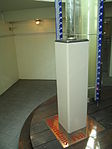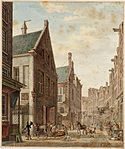Hotel Polen fire
The Hotel Polen fire occurred on 9 May 1977 in Amsterdam, the Netherlands. The conflagration destroyed the Hotel Polen (Hotel Poland), a five-story hotel in the centre of the city which had been built in 1891, as well as the furniture store on the ground level and a nearby bookstore. Many of the tourists staying at the hotel (of whom the majority were Swedes) jumped to their deaths trying to escape the flames. Upon their arrival, the fire department used a life net to help people escape, but not everyone could be saved. The incident resulted in 33 deaths and 21 severe injuries. The cause of the fire is unknown. In 1986 the Polish-born artist Ania Bien created a photographic installation based on the fire which compared it to the Holocaust. The hotel was located between the Kalverstraat (no. 15–17) and the Rokin (no. 14), near the present day Madame Tussauds. Its place is now occupied by the Rokin Plaza, originally an office building, which today houses several fashion shops.
Excerpt from the Wikipedia article Hotel Polen fire (License: CC BY-SA 3.0, Authors).Hotel Polen fire
Papenbroekssteeg, Amsterdam Centrum
Geographical coordinates (GPS) Address Nearby Places Show on map
Geographical coordinates (GPS)
| Latitude | Longitude |
|---|---|
| N 52.37211 ° | E 4.89264 ° |
Address
Papenbroekssteeg
Papenbroekssteeg
1012 KR Amsterdam, Centrum
North Holland, Netherlands
Open on Google Maps









